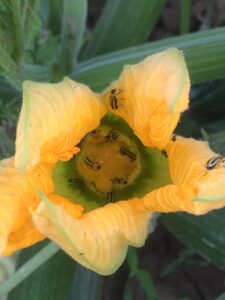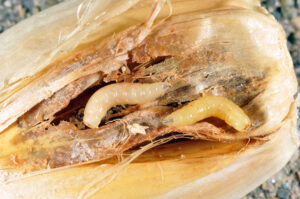The warm weather of late did not only pull us out of our winter slumber but definitely awoke some of our overwintering pests as well. Cucumber beetles and seedcorn maggots are likely on the hunt for food, and your early-season crops may be exactly what they are looking for.
Striped cucumber beetles (Figure 1) are looking for any plant in the family Cucurbitaceae, and they are hungry. Squash, and maybe some high tunnel cucumber plants, are likely what they will find on our farms. While some of these individuals may be harboring bacterial wilt (the disease they transmit), the greatest threat at this point is shear defoliation of our small plants. A soil drench of a systemic insecticide, at the lowest label rate, will give you early-season protection and minimize impacts on beneficial insects. Remember, though, the lowest rate is effective. Apply it when the plants go into the field, not when starting seeds in the greenhouse. If you are growing on smaller acreage, a physical barrier, like low tunnels, can be installed and are effective until your crop begins to bloom.
The other threatening pests are seedcorn maggots or, less commonly, onion maggots (Figure 2). These pests will impact early onion production and potentially other young, transplanted crops. The adults overwinter and are now flying around, looking for fields with high organic matter and young plants to deposit their eggs. The eggs will then hatch, and the larvae (maggots) feed below ground on the roots. If you see wilting plants in the field, loosen the soil around the plant and pull the plant and remaining roots up from the ground. Investigate the roots from small, white to translucent maggots and reduced root systems. This pest is then likely the culprit. You can check out this Youtube video about maggot damage on onions.
Consult the latest Midwest Vegetable Production Guide for pest management recommendations. The Guide can be found online at mwveguide.org.
Hopefully, the cold we are experiencing now upsets the pests as much as it has us!

